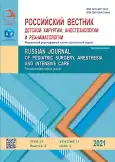Экстракорпоральная детоксикация при септических осложнениях у детей в остром периоде тяжелой сочетанной черепно-мозговой травмы
- Авторы: Новикова Т.А.1, Елецкая Е.В.1, Иванова Т.Ф.1, Амчеславский В.Г.1
-
Учреждения:
- Научно-исследовательский институт неотложной детской хирургии и травматологии
- Выпуск: Том 11, № 2 (2021)
- Страницы: 151-160
- Раздел: Оригинальные исследования
- URL: https://journal-vniispk.ru/2219-4061/article/view/123176
- DOI: https://doi.org/10.17816/psaic938
- ID: 123176
Цитировать
Полный текст
Аннотация
Введение. Клиническое применение методов экстракорпоральной детоксикации у пациентов с тяжелой сочетанной черепно-мозговой травмой имеет ряд особенностей и ограничений в связи с внутричерепной гипертензией, травматическим отеком головного мозга и риском их нарастания в ходе проведения процедур. В современной литературе ограниченно представлены результаты использования методов экстракорпоральной детоксикации при тяжелой сочетанной травме у детей и практически отсутствуют данные о возможности их применения при тяжелой сочетанной черепно-мозговой травме, что определяет актуальность исследований в данном направлении.
Цель — улучшение результатов лечения пострадавших детей с тяжелой сочетанной черепно-мозговой травмой с присоединением септических осложнений, применением методов экстракорпоральной детоксикации.
Материалы и методы. Представлен анализ опыта использования методов экстракорпоральной детоксикации, включающий продленную вено-венозную гемодиафильтрацию, LPS-сорбцию, а также мембранную плазмасепарацию при интенсивной терапии детей с тяжелой сочетанной черепно-мозговой травмой, осложнившейся развитием сепсиса и септического шока.
Результаты. Применение методов экстракорпоральной детоксикации способствовало выведению пациентов с тяжелой сочетанной черепно-мозговой травмой из септического шока, стабилизации гемодинамических показателей, параметров внутреннего гомеостаза, регрессу полиорганной недостаточности. Мониторинг внутричерепного давления и предупреждение развития дисэквилибриум-синдрома позволили избежать нарастания внутричерепной гипертензии у исследуемых пациентов.
Заключение. Своевременное и адекватное применение методов экстракорпоральной детоксикации улучшает клиническое течение острого периода травматической болезни у детей с тяжелой сочетанной черепно-мозговой травмой. Безопасность применения методов эфферентной терапии у пострадавших с тяжелой сочетанной черепно-мозговой травмой обеспечивается инвазивным мониторингом внутричерепного давления и предупреждением развития дисэквилибриум-синдрома.
Полный текст
Открыть статью на сайте журналаОб авторах
Татьяна Александровна Новикова
Научно-исследовательский институт неотложной детской хирургии и травматологии
Автор, ответственный за переписку.
Email: increate.msk@mail.ru
ORCID iD: 0000-0003-4400-2457
SPIN-код: 1661-0509
врач анестезиолог-реаниматолог отделения анестезиологии и реанимации
Россия, 119180, Москва, ул. Большая Полянка, д. 22Елена Владимировна Елецкая
Научно-исследовательский институт неотложной детской хирургии и травматологии
Email: eleckaya@inbox.ru
ORCID iD: 0000-0002-2678-4865
SPIN-код: 5455-4751
врач анестезиолог-реаниматолог высшей квалификационной категории отделения анестезиологии и реанимации
Россия, 119180, Москва, ул. Большая Полянка, д. 22Татьяна Фёдоровна Иванова
Научно-исследовательский институт неотложной детской хирургии и травматологии
Email: tat93320342@yandex.ru
ORCID iD: 0000-0001-6788-5091
SPIN-код: 3669-1982
врач анестезиолог-реаниматолог высшей квалификационной категории, заведующая отделением анестезиологии и реанимации
Россия, 119180, Москва, ул. Большая Полянка, д. 22Валерий Генрихович Амчеславский
Научно-исследовательский институт неотложной детской хирургии и травматологии
Email: vamches@mail.ru
ORCID iD: 0000-0002-6880-8060
SPIN-код: 5095-9316
доктор медицинских наук, профессор, руководитель отделения анестезиологии и реанимации
Россия, 119180, Москва, ул. Большая Полянка, д. 22Список литературы
- Krasnoyarov GA, Vaulina AV, Kozlov OO. Analysis of the treatment of polytrauma in children and adolescents. Klinicheskaya Medicina. 2009;(2):55–60. (In Russ.)
- Novokshonov AV, Lastaev TV. Traumatic brain injury in children with polytrauma. Politravma. 2015;(1):23–28. (In Russ.)
- Humanenko EK. Actual problems of concomitant injuries (clinical and pathogenetic aspects). Klinicheskaya Medicina i Patofiziologiya. 1995;1:9–21. (In Russ.)
- Khoroshilov SE, Karpun NA, Ilchenko AM, et al. Extracorporeal detoxification in patients with severe concomitant trauma. Obschaya Reanimatologiya. 2009;5(5):16–19. (In Russ.)
- Khoroshilov SE, Karpun NA, Ilchenko AM, et al. High-volume hemodiafiltration in a victim with massive crush of soft tissues in severe concomitant injury. Medical Journal of the Russian Federation. 2010;16(6):51–53. (In Russ.)
- Puras YuV, Talypov AE, Krylov VV. Mortality in victims with severe concomitant traumatic brain injury. Neirohirurgiya. 2010;(1):9–31. (In Russ.)
- Timofeev VV, Bondarenko AV. Epidemiological aspects of polytrauma in children in a large city. Politrauma. 2012;(4):5–8. (In Russ.)
- Akhmedov MM, Musaev TS. Analysis of combined and multiple injuries in children after a road traffic accident. Vestnik Ekstrennoi Medicini. 2015;(2):19–20. (In Russ.)
- Gupta DK, Kumar H, Mahapatra AK. Role of Invasive ICP Monitoring in Patients with Traumatic Brain Injury. Indi J Neurotrauma. 2006;3(1):31–36. doi: 10.1016/S0973-0508(06)80007-9
- Gorbachev VI, Likholetova NV, Gorbachev SV. Intracranial Pressure Monitoring: Present and Perspective (Communication 1). Politrauma. 2013;(4):69–78.
- Chaudhary AK, Tewari A. Increased Intracranial Pressure. Anaesth Clin Pharmacol. 2005;21(3):247–256.
- Czosnyka M, Picard JD. Monitoring and interpretation of intracranial pressure. J Neurol Neurosurg Psychiatr. 2004;75(6):813–821. doi: 10.1136/jnnp.2003.033126
- Eide PK, Egge A, Due-Tennessen BJ, Helseth E. Is Intracranial Pressure Waveform Analysis Useful in the Management of Pediatric Neurosurgical Patients? Pediatr Neurosurg. 2007;43(6):472–481. doi: 10.1159/000108790
- Jennifer R, Voorhees BA, Aaron A, et al. Early evolution of neurological surgery: conquering increased intracranial pressure, infection, and blood loss. Neurosurg Focus. 2005;18(4):14–18. doi: 10.3171/foc.2005.18.4.3
- Fakhry SM, Trask AL, Waller MA, Watts DD. Management of brain-injured patients by an evidence-based medicine protocol improves outcomes and decreases hospital charges. Cent Nerv. 2004;56:492–499. doi: 10.1097/01.ta.0000115650.07193.66
- Robertson CS Valadka AB, Hannay HJ. Prevention of secondary ischemic insults after severe head injury. Crit Care Med. 1999;27(10):2086–2095. doi: 10.1097/00003246-199910000-00002
- Smirnov AV. Renal replacement therapy. Nefrologiya. 2011;15(1):33–46. (In Russ.) doi: 10.24884/1561-6274-2011-15-0-33-46
- Holt S, Moore K. Pathogenesis of renal failure in rhabdomyolysis: The role of myoglobin. Exp Nephrol. 2000;(8):72–76. doi: 10.1159/000020651
- Wuhl E, Trivelli A, Picca S, et al. Strict blood-pressure control and progression of renal failure in children. N Engl J Med. 2009;361(17):1639–1650. doi: 10.1056/NEJMoa0902066
- National Kidney Foundation. K/DOQI. 2006 updates clinical practice guidelines and recommendations. Available: https://docplayer.net/16321596-2006-updates-clinical-practice-guidelines-and-recommendations.html
- Kolykhalkina IA, Chernysheva TA, Amcheslavsky VG, et al. Protocol for stepwise therapy of intracranial hypertension in the acute period of severe mechanical trauma. Russian Journal of Pediatric Surgery, Anesthesia and Intensive Care. 2013;3(2):74–78.
- Mukhoedova TV, Unarokov ZM, Malov AA. Jekstrakorporal’naja detoksikacija v lechenii bol’nyh s ostrym povrezhdeniem mozga. Patologiya Krovoobrascheniya i Kardiohirurgiya. 2010;(3):35–39.
- Burov AI, Savin IA, Abramov TA, Korotkov DS, Kostritsa NS. Complex intensive therapy using a combined technique of extracorporeal detoxification in a patient with septic shock after neurosurgical intervention. Anesteziologiya i Reanimatologiya. 2019;(5):81–87. doi: 10.17116/anaesthesiology201905181.
Дополнительные файлы







